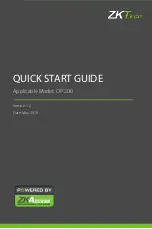
7
Setting up a PROFIBUS-DP Network
Section 1-2
1-2
Setting up a PROFIBUS-DP Network
1-2-1
Configuring the PROFIBUS-DP Master
In order to operate a PROFIBUS network, each master in the network needs
to be configured. This process of PROFIBUS master configuration involves
• setting up the network topology, i.e. assigning the slave stations with
which the master will be exchanging data,
• defining the parameterization data, which the master will send to each of
the slave devices, before process data exchange can commence
• defining the configuration data, i.e. defining the process data, which will
be exchanged,
• setting up the bus parameters, which define the baud rate and the bus
timing parameters.
• downloading the configuration setup to the master device.
Configuration technology
The configuration process is usually facilitated by a special Computer based
program, often referred to as a Configurator. The Configurator requires spe-
cial configuration files, defining the configuration options for each device,
which is to participate in data exchange. The files must be provided by the
manufacturer of the device.
Two types of configuration technology exist:
• Configuration technology based on FDT/DTM technology
• Configuration technology based on GSD-files
1-2-2
FDT/DTM Technology
FDT/DTM technology
The newer configuration tools are based on FDT/DTM technology.
FDT/DTM Concept
The FDT/DTM concept specifies the interfaces between the engineering sys-
tems called Field Device Tools (FDT), and the device-specific software com-
ponents called Device Type Managers (DTM).
The FDT/DTM concept separates the device dependent functionality (which is
in the DTM) from the application. It opens up interfaces for device configura-
tion, monitoring and maintenance solutions, which before were largely manu-
facturer-specific interfaces. Because of this concept, FDT/DTM technology is
not limited to PROFIBUS applications. In concept, any type of network can be
configured and accessed, provided the appropriate DTMs are available.
FDT Container application
A FDT container application facilitates configuration of network devices and
parameterizing and/or manipulating their operational modes. All device
dependent functionality is concentrated in the DTM.
FDT container applications can be stand-alone tools, or can be part of other
engineering tools such web browsers providing FDT interfaces.Since FDT
standardizes the interfaces, it allows devices from different manufacturers to
be integrated in any automation system, regardless of the fieldbus system.
CX-Profibus is an example of a FDT container application. It is described in
detail in the following sections.
Device DTM
DTMs are provided by the manufacturer of the device. A DTM is comparable
to a printer driver, which allows interactive configuration and diagnostics.
The DTM provides not only the configuration, manipulation and monitoring
functions for a device including the User interface functions, it also provides
the connection technology to the device.
Содержание SYSMAC CJ1W-PRM21
Страница 2: ...iv...
Страница 36: ...22 Basic Operating Procedure Section 1 5...
Страница 52: ...38 Defining PROFIBUS DP in the Software Section 2 5...
Страница 112: ...98 Allocated CIO Area Words Section 4 2...
Страница 122: ...108 Command Response Reference Section 5 2...
Страница 160: ...146 Replacing the Unit Section 7 8...
Страница 174: ...160 Appendix...
Страница 180: ...166 I O Data Conversions Appendix D...
Страница 186: ...172 Configurator Error and Warning Messages Appendix E...
Страница 187: ...173 Index...
Страница 188: ...174 Index...
Страница 190: ...176 Revision History...
















































